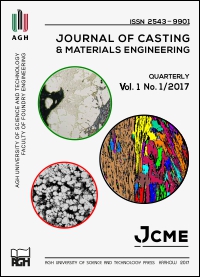The effect of nickel on shaping the structure of Al-Cu-Mn alloys
DOI:
https://doi.org/10.7494/jcme.2017.1.1.20Abstract
This study investigated the effect of nickel on shaping the structure of aluminum alloys of the Al-Cu-Mn type in the “as-cast”
condition and after heat treatment according to the T6 procedure. The aluminum alloys of type Al-5%Cu-1%Mn, containing
nickel in a range of up to 1.9%, were taken into consideration in this work. Experiments were carried out for thin-walled
thickness casting (g = 5 mm) and for reference casting with a wall thickness of g = 35 mm. Metallographic investigations
of both the macro- and micro-structure were conducted to estimate the secondary dendrite arm spacing (SDAS), average
diameter (dav) of the primary α (Al) grains, and surface fraction of the interdendritic phases (f). Moreover, the degree
of dissolution of these interdendritic phases during the solution treatment process was determined. An SEM-EDS analysis
was conducted, from which it follows that the addition of nickel at the level of 0.5% changes the un-dissolved particles
from a needle-like β-Fe shape to blocky and coagulated. Higher additions of nickel starting from 0.88%) give rise to as many
as four phases with higher copper content, the deficit of which results in the smaller strengthening effect of α (Al) dendrites.
Downloads
References
Elgallad E.M., Samuela F.H., Samuela A.M. & Dotyc H.W. (2010). Machinability aspects of new Al-Cu alloys intended for automotive castings. Journal of Materials Processing Technology, 210(13), 1754–1766.
Polmear I.J., Pons G., Barbaux Y., Octor H., Sanchez C., Morton A.J., Borbidge W.E. & Rogers S. (1999). After concorde: evauation of creep resistant Al-Cu-Mg-Ag alloys. Materials Science and Technology, 15(8), 861–868.
Elgallad E., Samuel F., Samuel A. & Doty H. (2009). Development of new Al-Cu based alloys aimed at improving the machinability of automotive castings. International Journal of Metalcasting, 3(2), 29–41.
Górny M. & Sikora G. (2015). Effect of titanium addition and cooling rate on primary α(Al) grains and tensile properties of Al-Cu alloy. Journal of Materials Engineering and Performance, 24(3), 1150–1156. doi:10.1007/s11665-014-1380-2
Eskin D., Du Q., Ruvalcaba D. & Katgerman L. (2005). Experimental study of structure formation in binary Al-Cu alloys at different cooling rates. Materials Science and Engineering A, 405(1–2), 1–10. doi:10.1016/j.msea.2005.05.105
Grosselle F., Timelli G., Bonollo F., Tiziani A. & Della Corte E. (2009). Correlation between microstructure and mechanical properties of Al-Si cast alloys. La Metallurgia Italiana, 6, 25–32.
Monroe R. (2005). Porosity in castings. AFS Transactions, 113, 519–546. doi:10.1002/chin.200642218
Pietrowski S. (2011). Crystallisation and microstructure of low-silicon silumins with alloy additions. Archives of Foundry Engineering, 11(3), 113–124.
Sikora G. (2015). Wpływ miedzi na strukturę pierwotną i przemianę eutektyczną w stopach Al-Cu. Archives of Foundry Engineering, 15(spec. 4), 113–118.
Szajnar J. (2002). Rozkład miedzi w kryształach kolumnowych w odlewach wykonywanych w polu magnetycznym. Archives of Foundry Engineering, 2(6), 213–218.
Djurdjevič M.B. & Grzinčič M.A. (2012). The effect of major alloying elements on the size of secondary dendrite arm spacing in the As-Cast Al-Si-Cu alloys. Archives of Foundry Engineering, 12(1), 19–24. doi:10.2478/v10266-012-0004-2
McCartney D.G. (1989). Grain refining of aluminum and its alloys using inoculants. International Materials Reviews, 34(5), 247–260.
Molina R., Amalberto P. & Rosso M. (2011). Mechanical characterization of aluminium alloys for high temperature applications. Part 2: Al-Cu, Al-Mg alloys. Metallurgical Science and Technology, 29(2), 5–13.
Kaufman J.G. & Rooy E.L. (2004). Aluminum Alloy Castings: Properties, Processes, and Applications. ASM International.
Zolotorevsky V.S., Belov N.A., Glazoff M.V. (2007). Casting Aluminum Alloys (1st ed.). Amsterdam: Elsevier.
Rohatgi P.K. & Prabhakar K.V. (1975). Wrought aluminum-nickel alloys for high strength-high conductivity applications. Metallurgical Transactions A, 6(5), 1003–1008. doi:10.1007/BF02661353
Hatch J.E. (1984). Aluminum: Properties and Physical Metallurgy. ASM International.
Mrówka-Nowotnik G. (2010). Examination of intermetallic phrases in AlCu4Ni2Mg2 aluminium alloy in T6 condition. Archives of Metallurgy and Materials, 55(2), 489–497.
Mrówka-Nowotnik G., Wierzbińska M., Sieniawski J. & Nowotnik A. (2015). Investigation of solidification process and microstructure examination of AlCu4Ni2Mg2 aluminium alloy. Advances in Manufacturing Science and Technology, 39(4), 61–69. doi:10.2478/amst-2015-0023
Belov N.A., Eskin D.G. & Avxentieva N.N. (2005). Constituent phase diagrams of the Al-Cu-Fe-Mg-Ni-Si system and their application to the analysis of aluminium piston alloys. Acta Materialia, 53(17), 4709–4722. doi:10.1016/j.actamat.2005.07.003
Downloads
Published
Issue
Section
How to Cite
Accepted 2017-01-05
Published 2017-03-17


